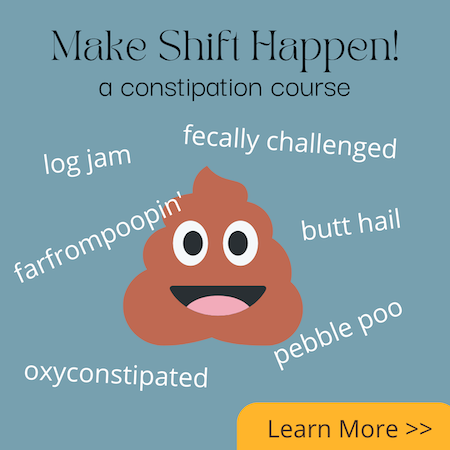Do you have a weak bladder?
I see bladder issues such as incontinence, frequent urination, cystocele (prolapse), and weak bladder happen to women as early as in their 20s. If you’re having bladder issues or want to avoid them, here are 12 things you need to address.
Things that can lead to bladder problems
-
- Do you hover over the toilet? If you’re grossed out by sitting on a public toilet, make yourself a nest of toilet paper to sit on, don’t hover. You may be thinking “but I thought squatting was good for the pelvic floor?” It can be, but hovering with your hips higher than your knees is not a resting squat. When you hover over the toilet your pelvic floor is actively participating in holding you up. The pelvic floor must relax to allow the external urethral sphincter to relax. If your pelvic floor is tense, you end up forcefully pushing pee out which interrupts the fine-tuned coordination between the nerves, brain, pelvic floor, and bladder.
- Some women are in such a hurry to get back to what they were doing, they end up forcefully pushing their pee out even if they are sitting on the toilet and not hovering. Chill out, stop bullying your bladder. You’re only saving like two seconds by forcefully pushing your pee out.
- Scar tissue or adhesions on your bladder can pull on the bladder and send signals to the brain that your bladder is full before it actually is, creating a sense of urgency. Learn how to work with your abdominal adhesions and c-section scar in my Free The Belly online course.
- Your uterus and your bladder hate restrictive clothing. Read more about how skinny jeans mess with your organs HERE.
- Stopping the flow of urine by doing Kegels on the toilet disrupts the natural pee reflex. Remember the pelvic floor needs to relax as you pee. Stop teasing your bladder with Kegels on the toilet.
- The small bladder myth. Having a small bladder is highly unlikely but an overactive bladder can make your bladder seem small. Frequently emptying your bladder ‘just in case’ can increase bladder sensitivity and decrease its capacity to hold urine. Pair an overactive bladder with a weak pelvic floor and it could lead to urge incontinence. The good news is, you can retrain your body, more on that in another article.
- Certain foods can be irritating to the bladder. Specifically coffee and tea (caffeinated and decaffeinated), tomato products, carbonated beverages, citrus juices, sweeteners, processed foods with artificial flavors, and preservatives.
- Habitually sucking in your belly can lead to pelvic organ prolapse and a weak hypertonic pelvic floor. The pelvic floor and respiratory diaphragm should work together. When you breathe in, the pelvic floor should elastically load, and when you exhale the pelvic floor should naturally rise, lifting the pelvic organs with it. Habitually sucking the belly in collapses the internal organ fascial support from the abdominal wall and increases the intraabdominal pressure toward the pelvic outlet and diaphragm, leading to constipation, hernias, prolapse, and incontinence.
- It’s not a weak bladder, it’s your pelvic floor! A weak pelvic floor can lead to leakage. Now, don’t start doing a bunch of Kegels. Sometimes too much tension in the pelvic floor can lead to a weak pelvic floor. The pelvic floor doesn’t work in isolation. See my suggestions in the links at the bottom of the page for more information.
- Don’t walk like a lady. Read my Walking Like a Lady article for more information on this. I also cover massage techniques and pelvic alignment for prolapsed bladder and frequent urination in my Womb Care online course. Remember the uterus and bladder are physically and functionally related!
- An anteflexed uterus can press on the bladder, especially right before your period when your uterus is heavier. See the video below.
- Holding in your pee.








Thank you
So appreciative
Happy New Year to you
Hello. I am having incontinence due to too much coughing. What articles or vídeos from your site would you recommend to me. Thanks a lot
It’s difficult to say without a thorough intake, but this article on the pelvic floor may be helpful. https://alignmentmonkey.nurturance.net/2012/body-building-your-vagina/
Of course, addressing the chronic cough is number one. But in the meantime, when you feel a cough coming on you could hinge forward at the hips (not bending forward at the waist, the hinging is coming from the hips-very important). When you cough in this position you should feel less pressure on the pelvic floor.